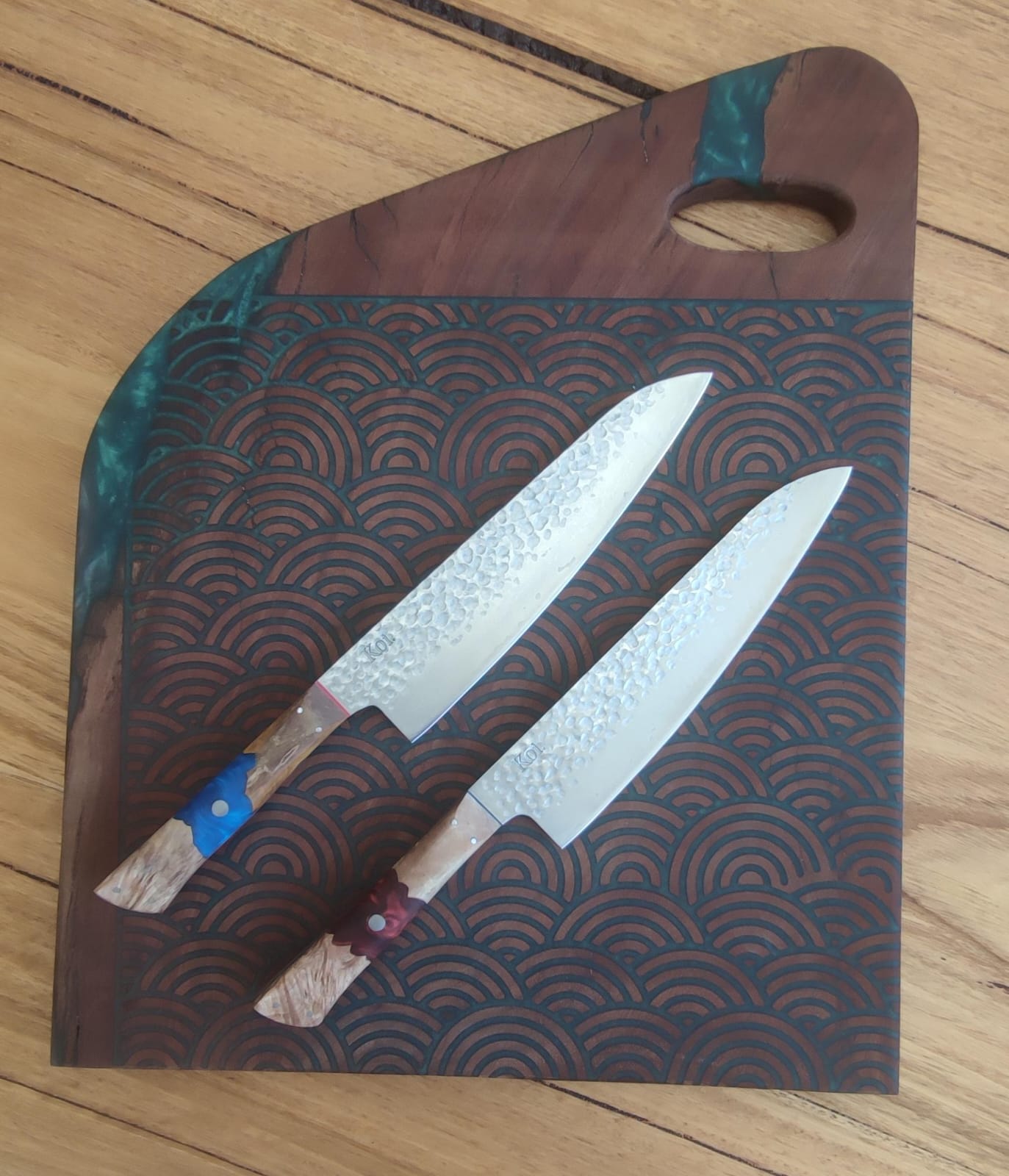Both of these knives are popular among chefs, but they have different purposes. A Santoku knife is designed for general-purpose cutting, while a Bunka knife is designed for more intricate cuts. Keep reading to learn more about these knives and find out which one is right for you.
What is a Santoku knife?
The Santoku is an excellent knife for the kitchen. It means "three virtues" in Japanese Kanji, referring to its ability to cut and slice easily while also being able to dice up vegetables like no other blade.
It is considered an allrounder in the kitchen, because it can be used for roll-cutting, chopping and slicing. Its unique sheepsfoot tip, bring more steel towards the tip of the blade, lending the knife an incredible balance in your hand.
The Santoku knife is also characterised by its super sharp, straight edge and slightly curved tip. This design allows the knife to rock back and forth, making it easier to chop vegetables without crushing or bruising them.

What is a Bunka knife?
The word "Bunka" means culture in Japanese, and this knife is definitely a cultural icon. It's a newer style of knife that became popular in the 1970s and is often compared to the Santoku knife.
It is often used to make sushi, sashimi, and other delicate cuts. The blade of a Bunka knife is usually longer than that of a Santoku knife, and its edge is flatter. We also have found most Bunkas have a wedge shape blade with larger heel of the blade. This helps with the angle your hand grips the blade, making roll cutting and slicing easy and intuitive.
Its distinctive feature is its K-tip which is designed for precision and accuracy. The K-tip is the reason why the Bunka knife is sometimes called a Kiritsuke knife, although they have distinct differences in length and shape. Functionally the K-tip reinforces the tip of the blade making it extra useful when needing to puncture ingredients like pumpkins.

What's the difference between these two types of knives?
The main difference between Santoku and Bunka knives is their purpose. Santoku knives are designed for general-purpose cutting, while Bunka knives are designed for more intricate cuts. They also differ in the below-mentioned aspects:
The shape of the blade
The Santoku knife is a versatile all-purpose kitchen knife with a sharp, straight edge and a slightly curved belly, making it perfect for a wide range of tasks.
On the other hand, the Bunka knife is designed specifically for precision cutting. It has a flatter edge and is often used for tasks like slicing herbs and mincing garlic.

The length of the blade
The Santoku knife has a blade of around 120 to 180 mm, whereas the Bunka knife has a blade ranging from 130 to 200mm. Santokus are often preferred in domestic kitchens as their size suits smaller benches and chopping boards.
The overall weight of the knives
The Santoku knife is often noticeably lighter than the Bunka knife, and this is due to its shorter length and thinner blade.
Thus, in terms of weight, the Santoku knife is the clear winner - it's lighter and more maneuverable, making it easier to control when chopping. However, the Bunka knife's extra width and length make it better suited for tasks that require more precision, such as slicing and dicing.
The handles of the knives
The Santoku knife has a resin composite handle, while the Bunka knife has a more traditional wooden handle.
You can get a Santoku knife with a "wa" handle or a western "yo" handle. They are further of the types: D, oval, and round. Similarly, the Bunka knife also has different types of handles, such as D-shaped, oval, and octagonal.
Material of the blade
The Santoku knife has a carbon steel or stainless steel blade, while the Bunka knife is often made of high-carbon stainless steel.
Carbon steel is harder than stainless steel and holds its edge longer. However, carbon steel knives require more care than stainless steel knives because they are susceptible to rusting.
Edge and sharpness
The Santoku knife hones to a 16-degree angle and can be quite sharp. The Bunka knife hones to a 12-degree angle and is extremely sharp.
Comparing the mincing functionality
The Santoku knife is better if you need to mince things into smaller bits for seasoning soups, sauces, salads, and other cuisines. It effortlessly minces food in a back-and-forth motion, whereas the Bunka can fall short. The Bunka excels at cutting into large starchy vegetables and for butchering meat, where the robust K-tip can be used for intricate work and the heft of the blade helps to cut through fibrous food.
Deciding based on dicing
Santoku can dice fruits and vegetables like an expert, even better than Bunka. It has the ideal blade for cutting perfect, even pieces. The Bunka can be great for dicing, but the curvature of the blade and its fine tip can be tricky to master.
Taking precision into account
The Bunka knife's sharp tip makes it suitable for delicate precision work, such as brunoise cuts or vegetable scoring. Because of its flat cutting edge and buly tip, the Santoku isn't as good at precision work.
So, which knife is the right fit for you?
The answer to this question depends on what you'll use the knife for. If you're looking for a versatile knife that can handle all sorts of tasks, then a Santoku knife is a good choice. But if you want a knife that's specifically designed for making delicate cuts, then the Bunka knife is a better option.
No matter which knife you go for, make sure to keep it sharpened and maintained so that it can last for years to come. With proper care, any of these knives will make a great addition to your kitchen. Till then, we wish you a happy chopping!





